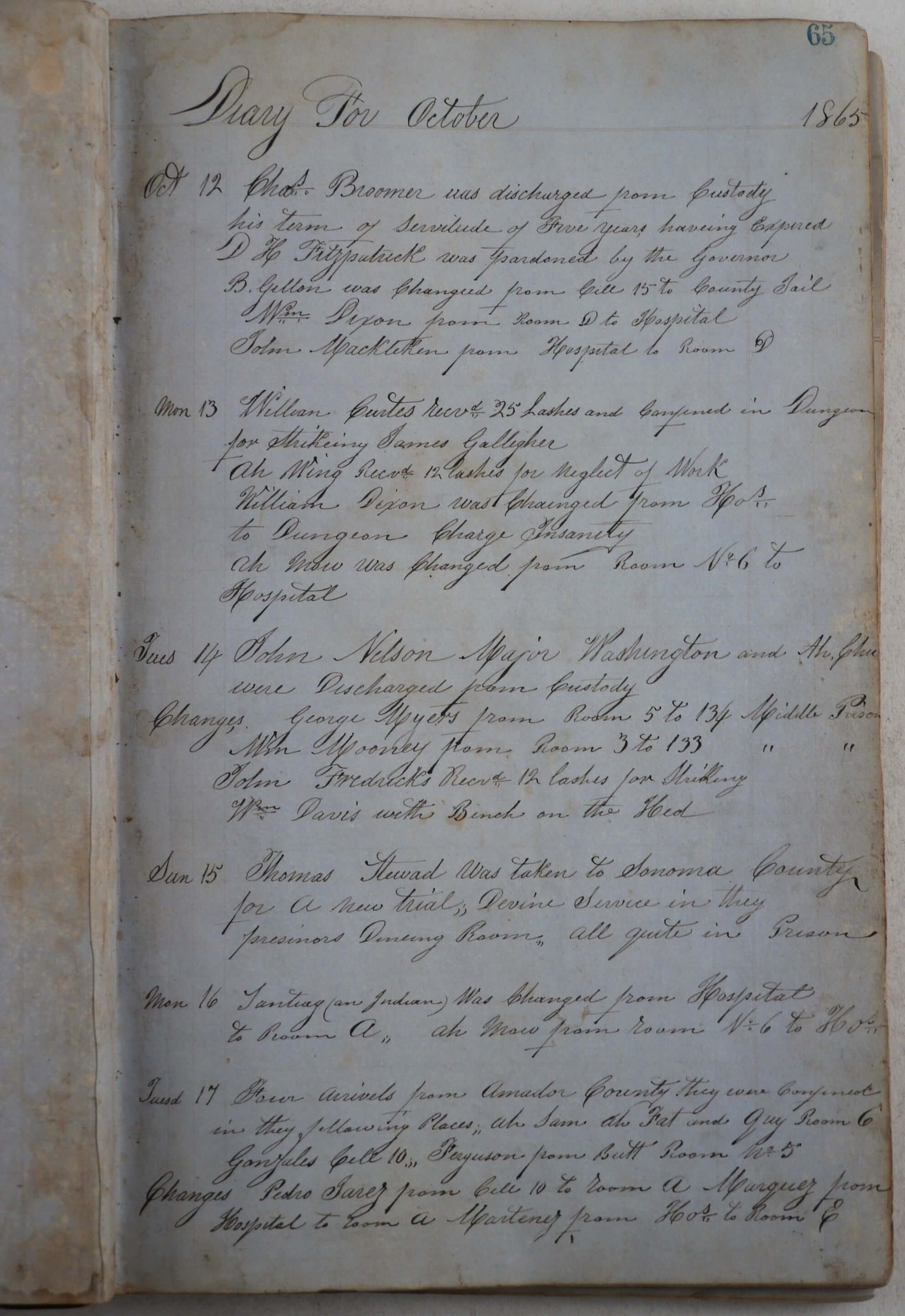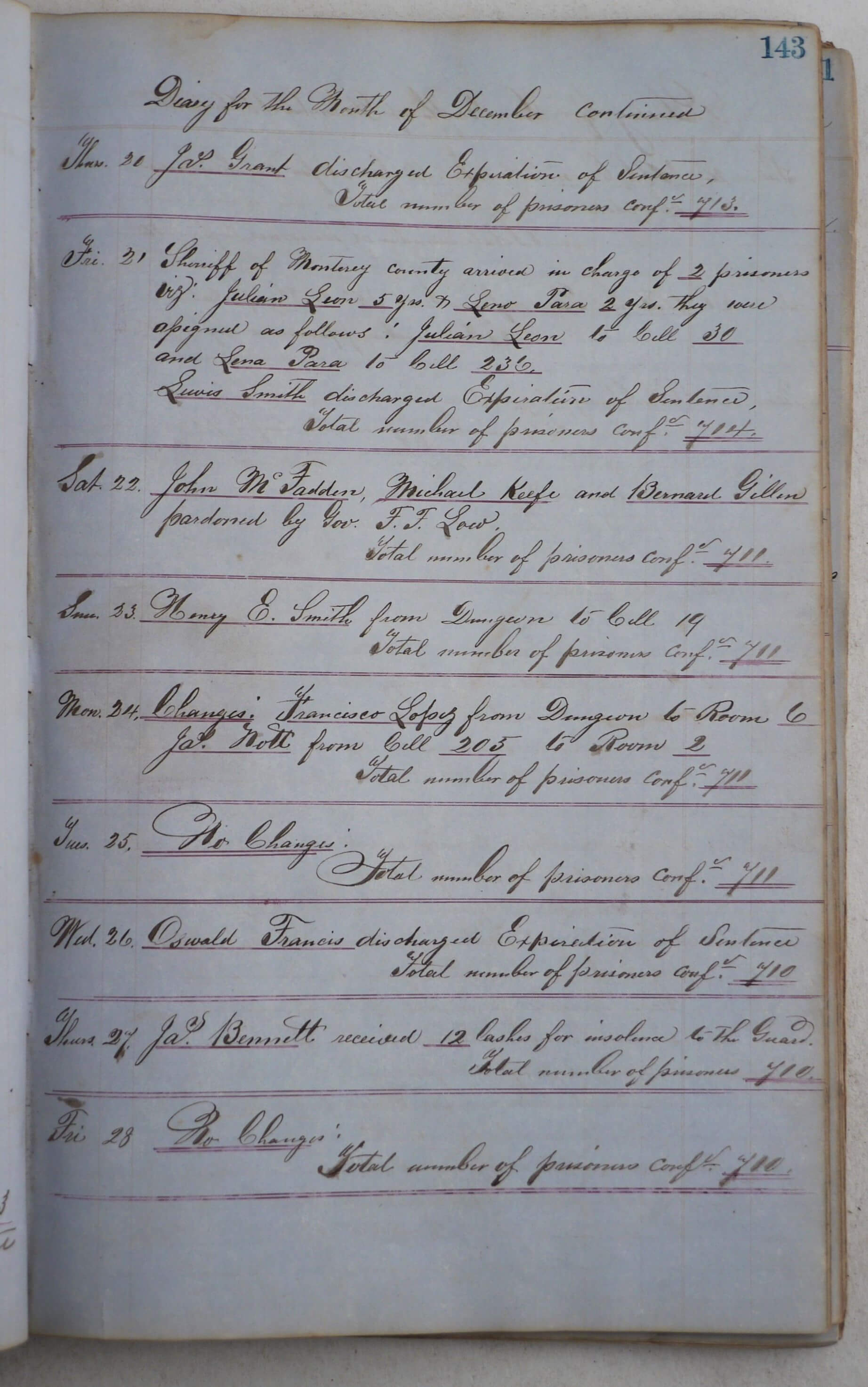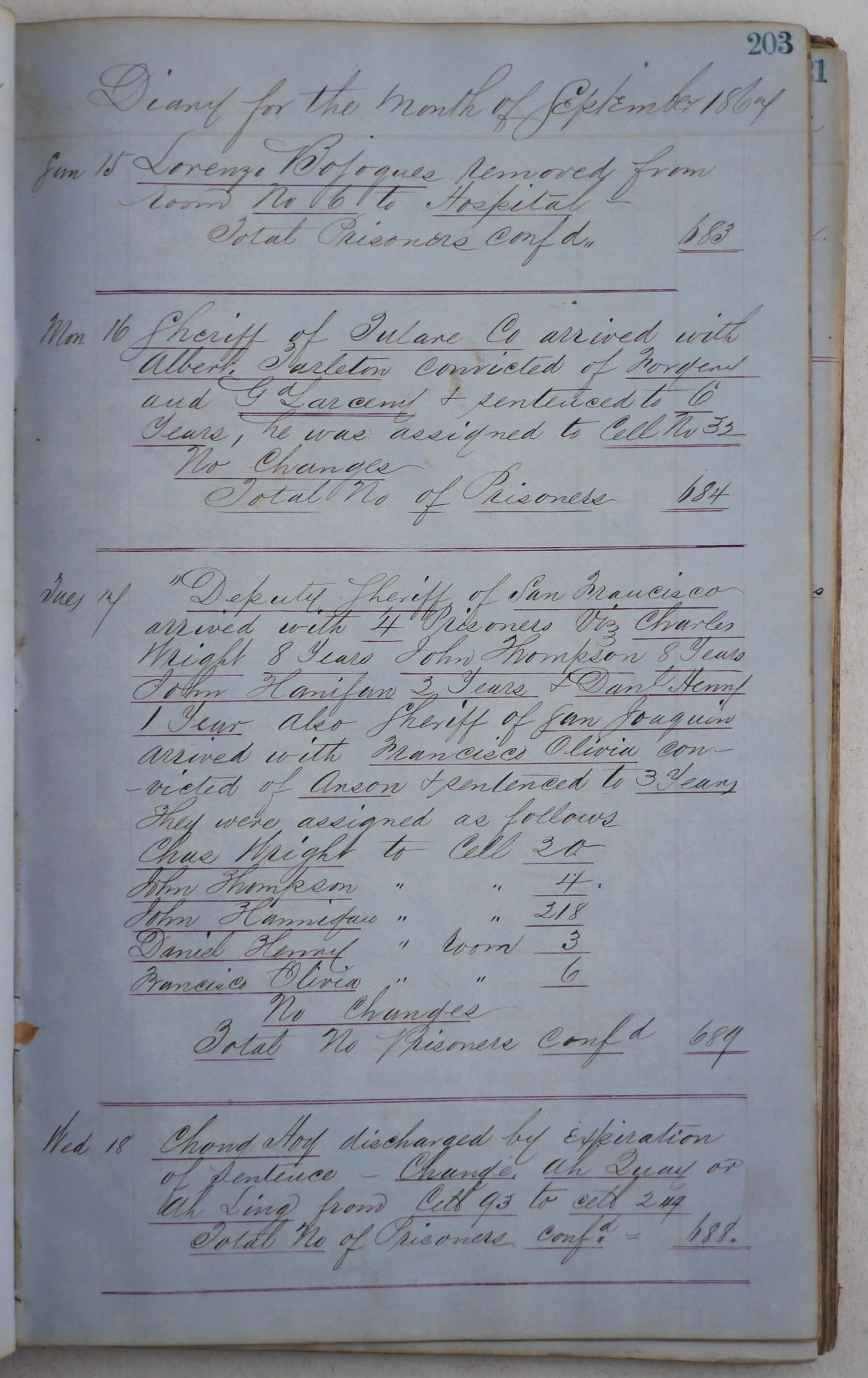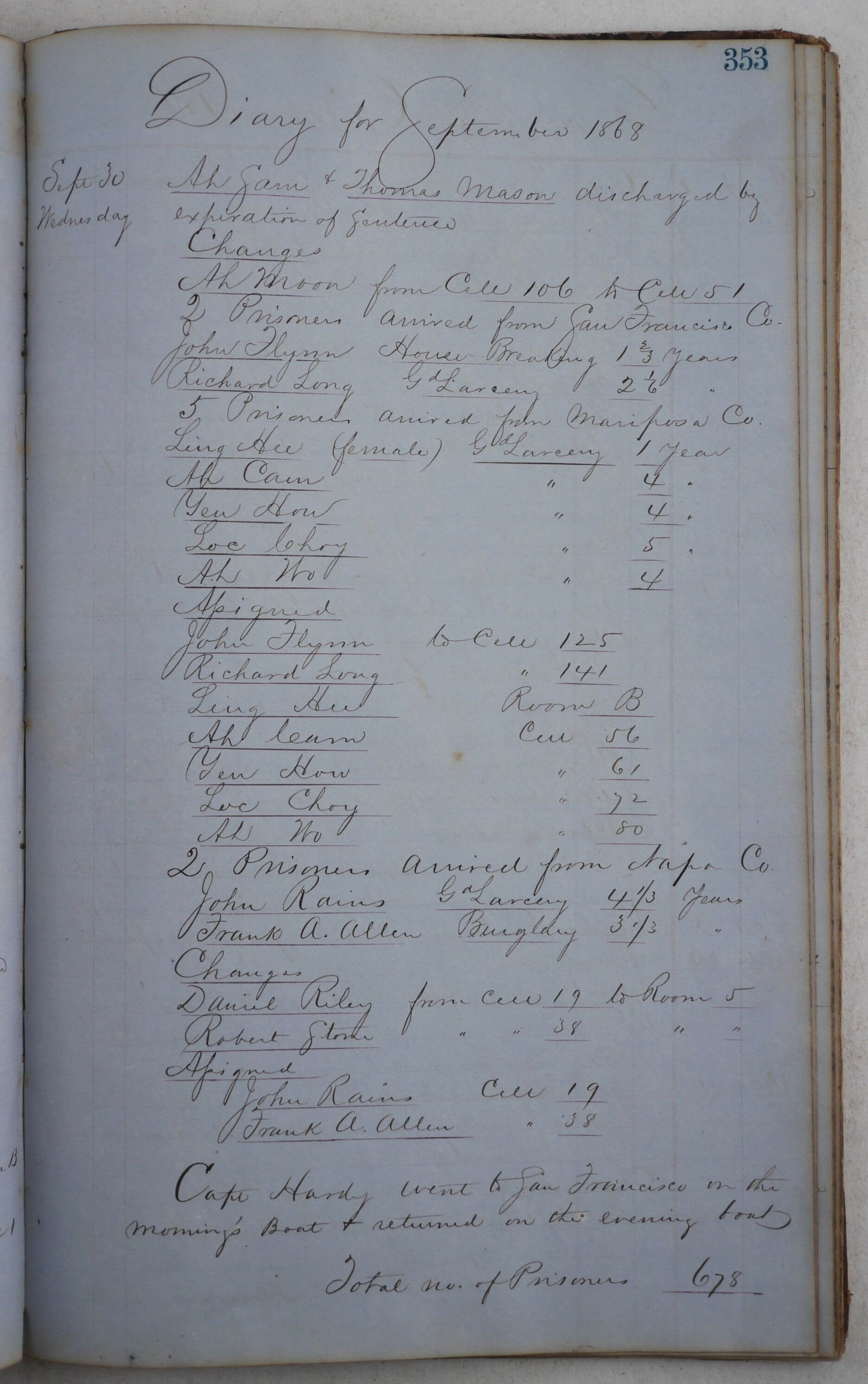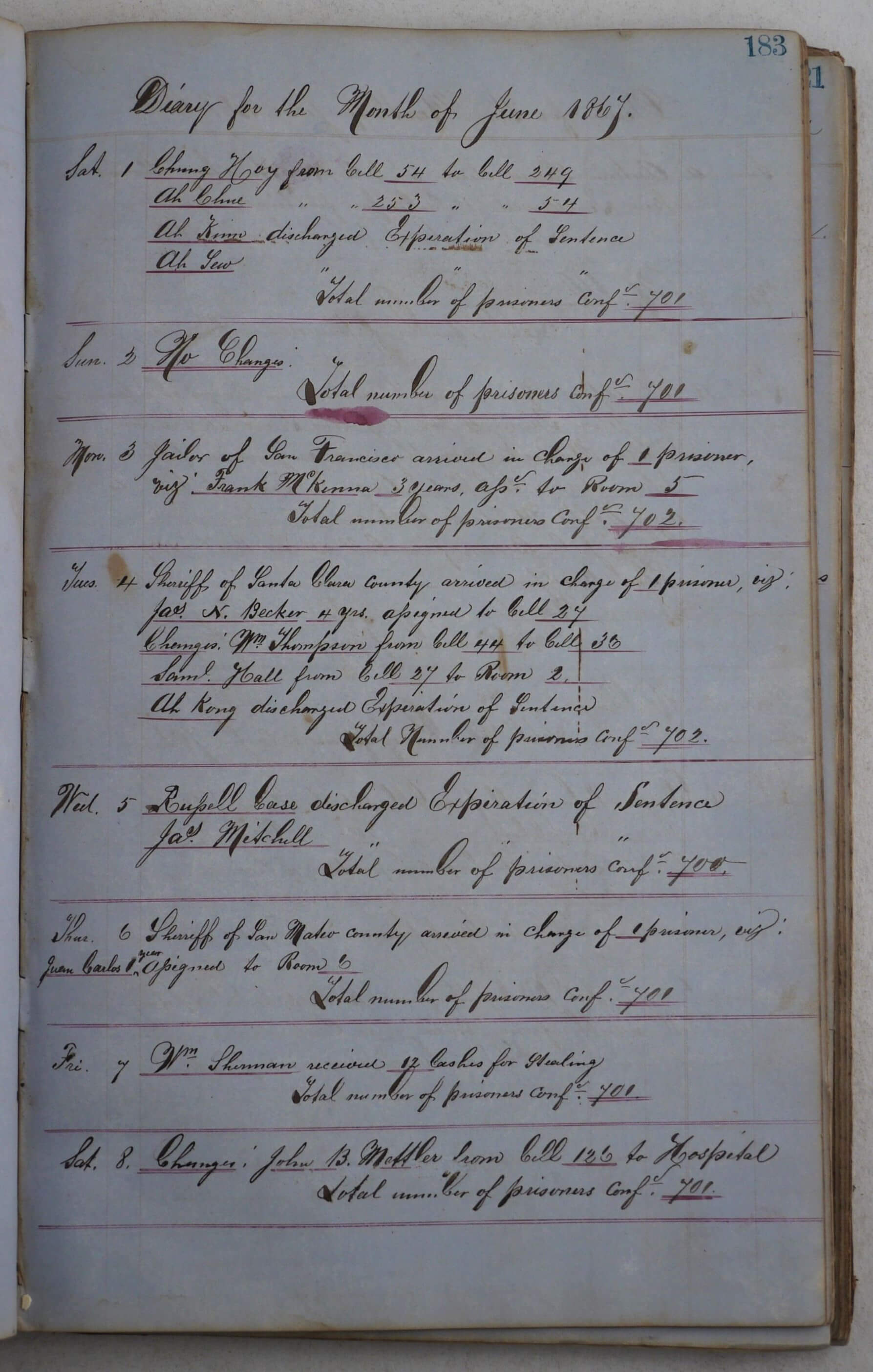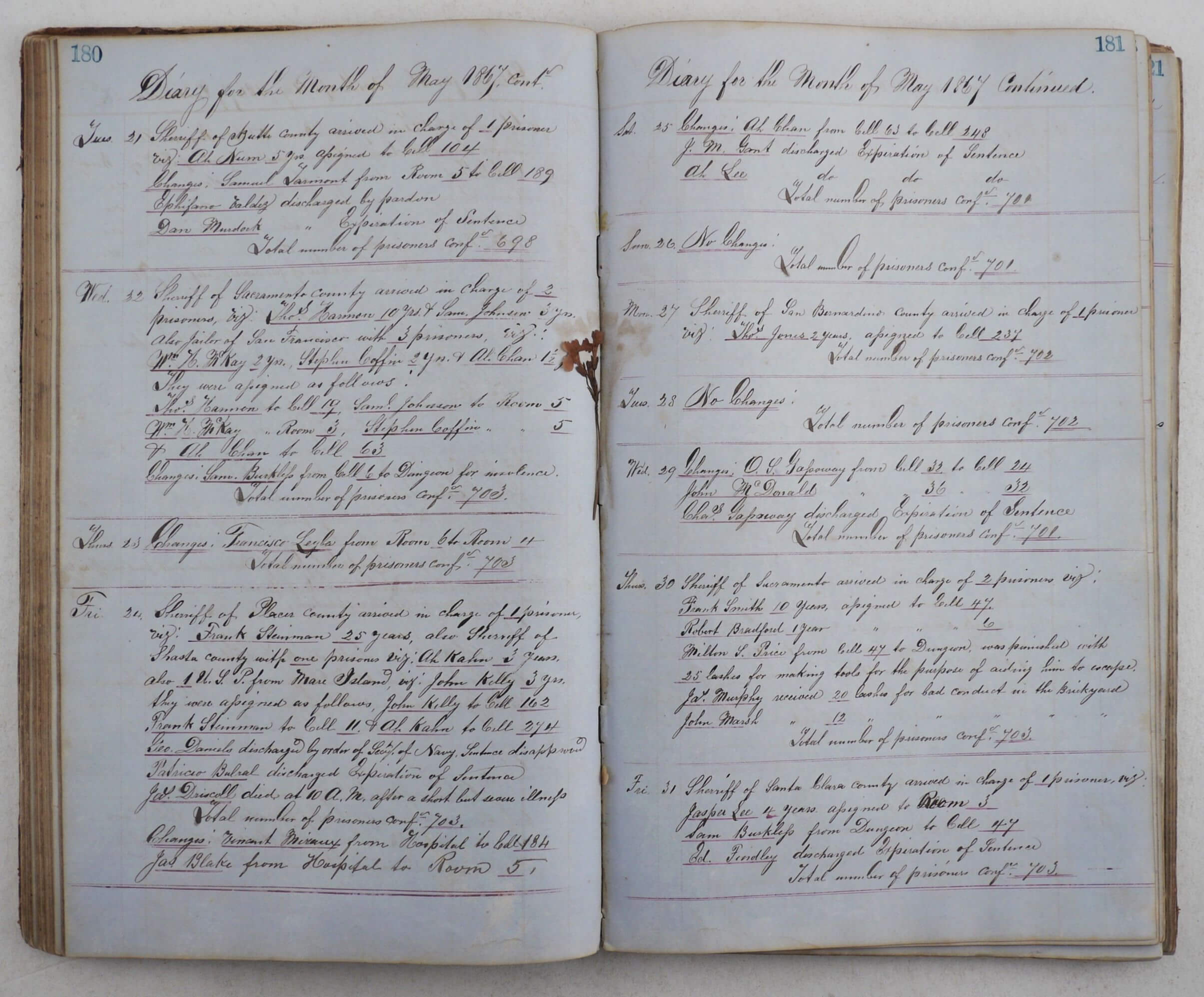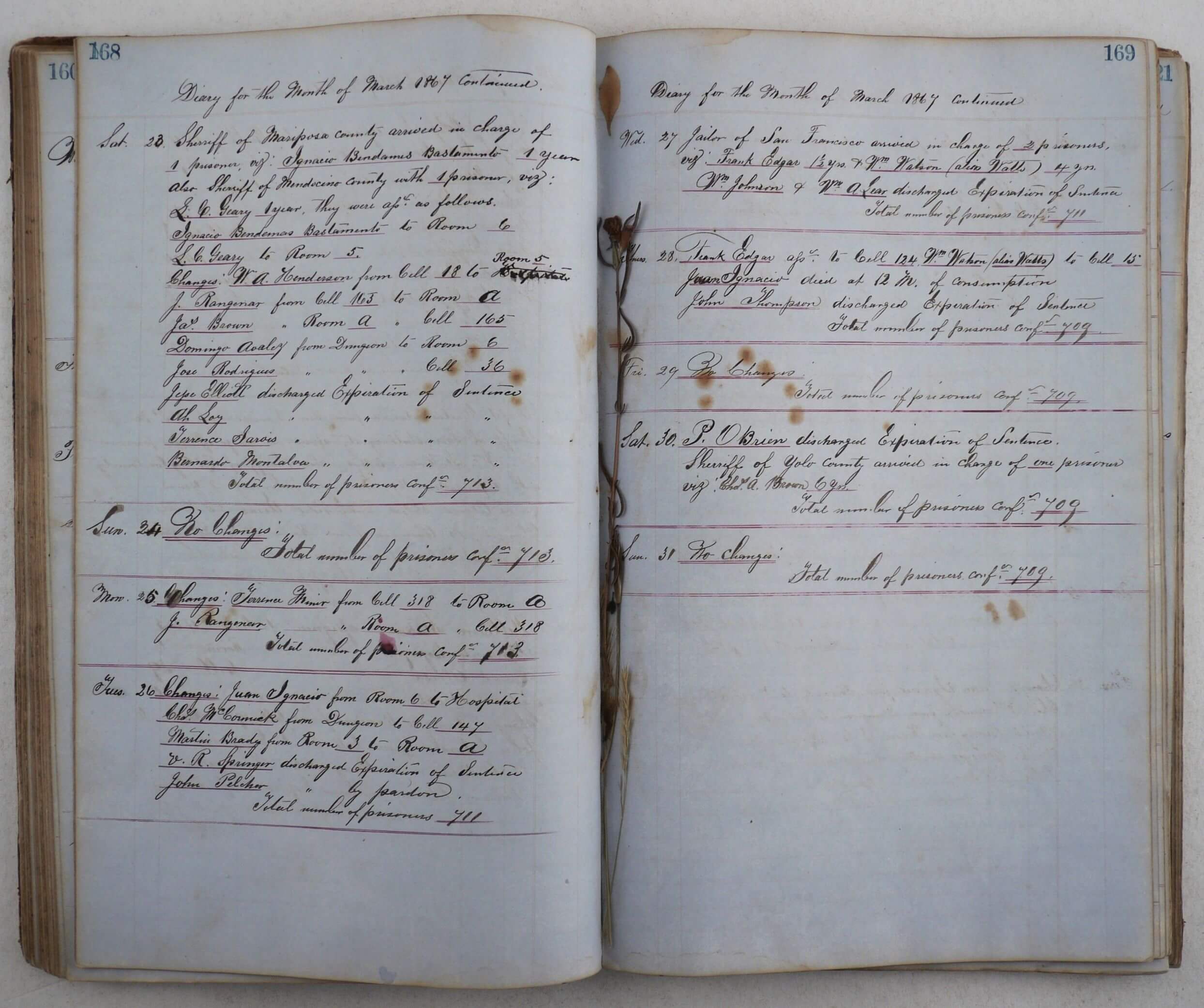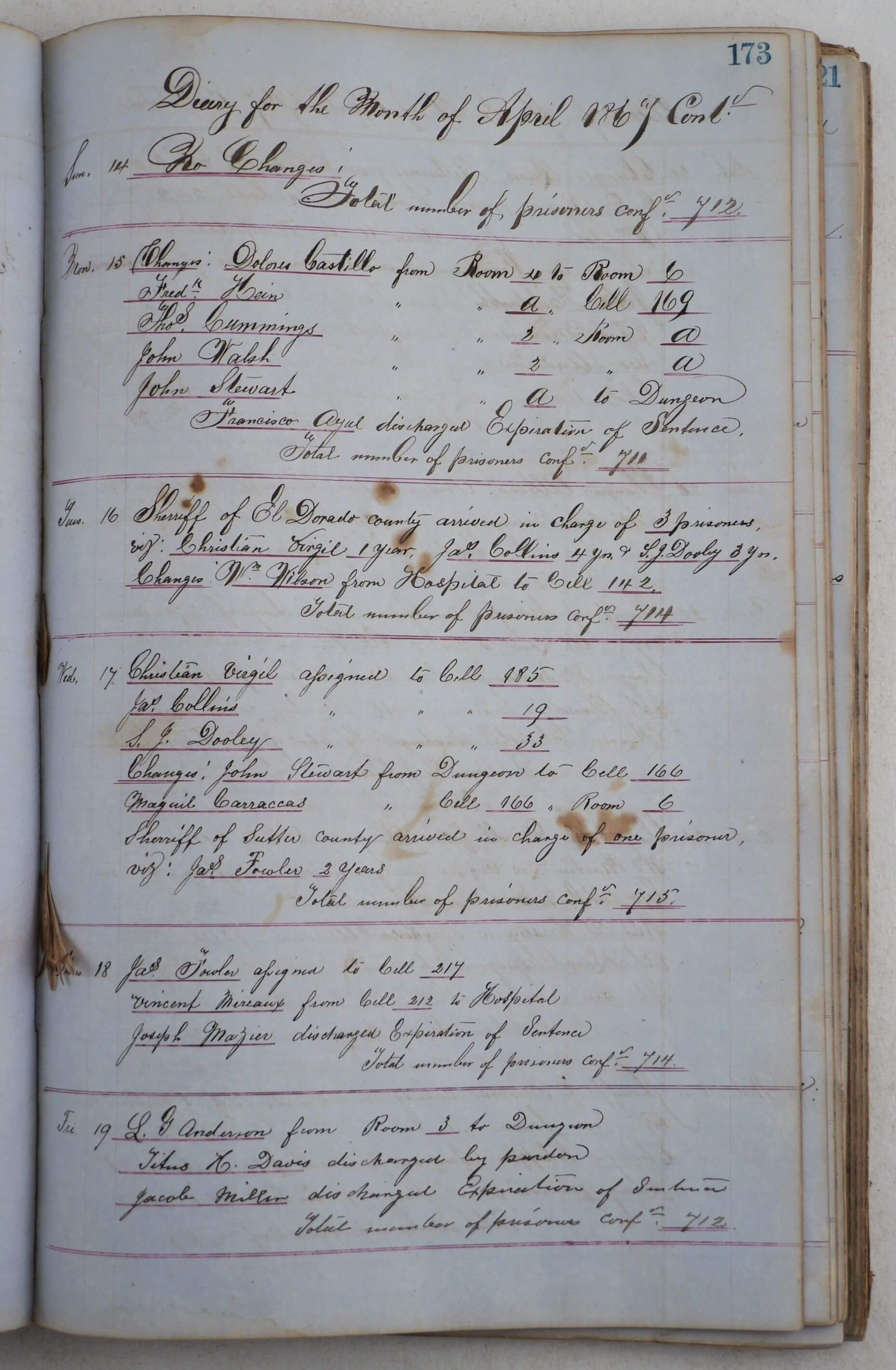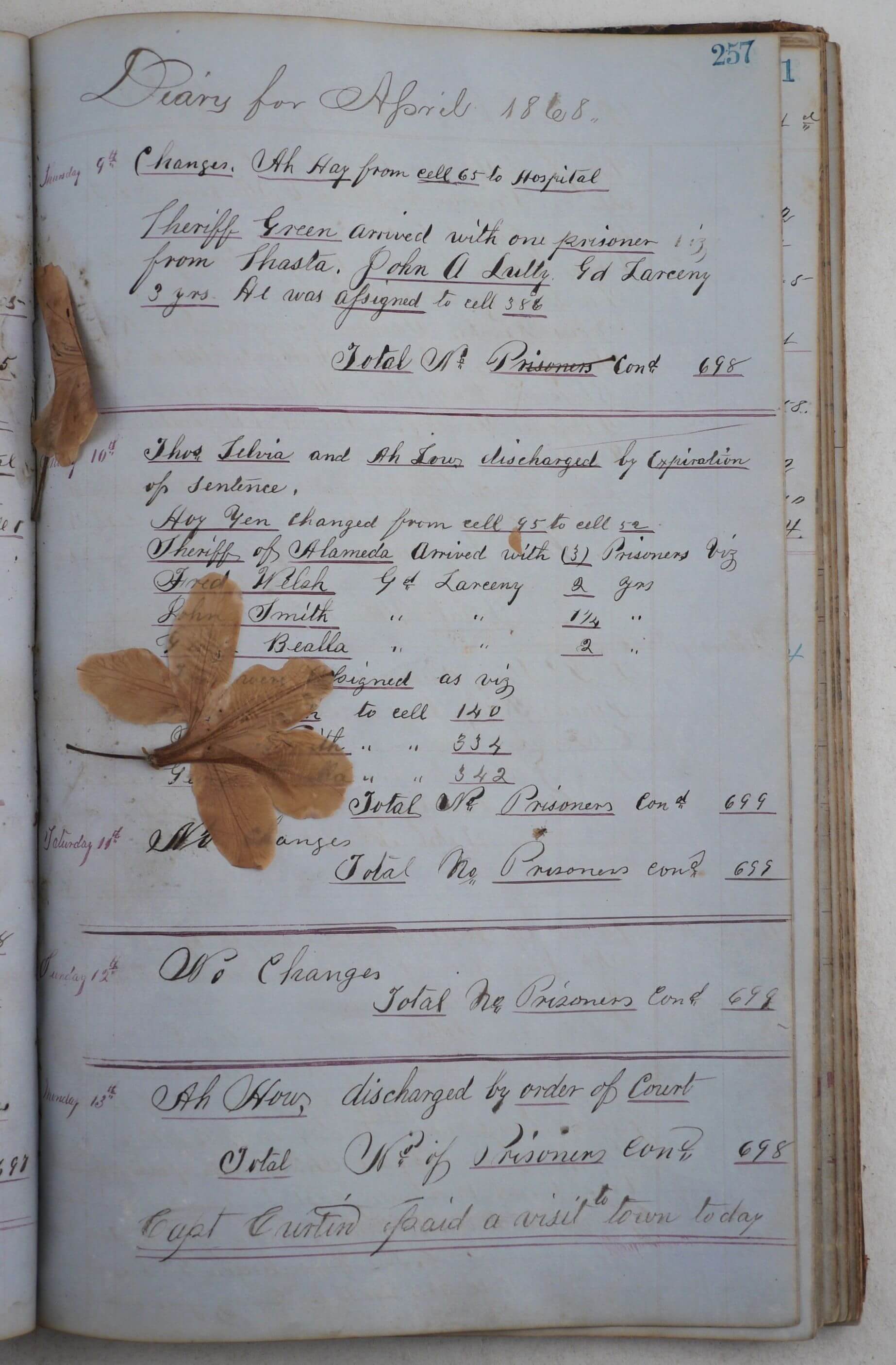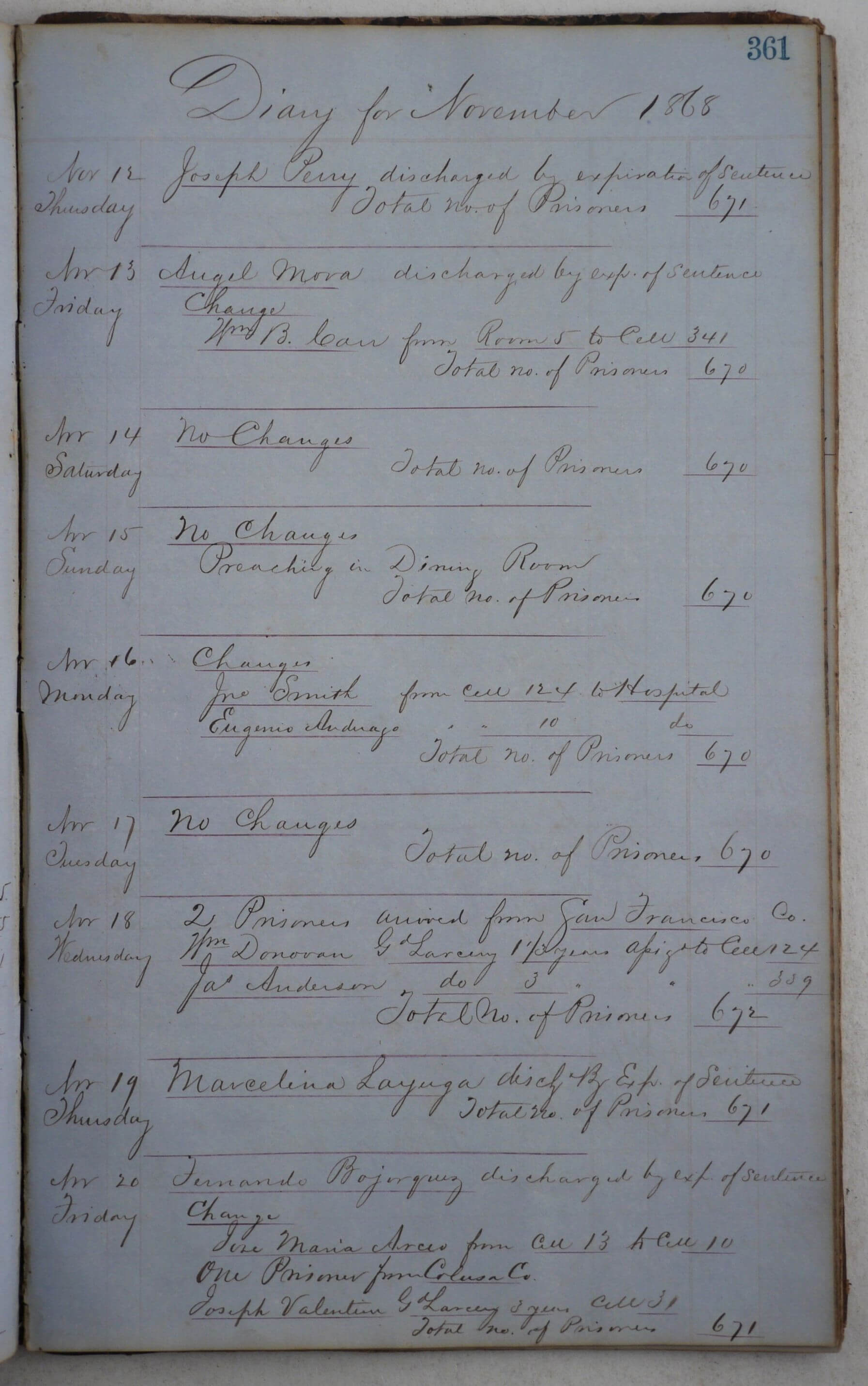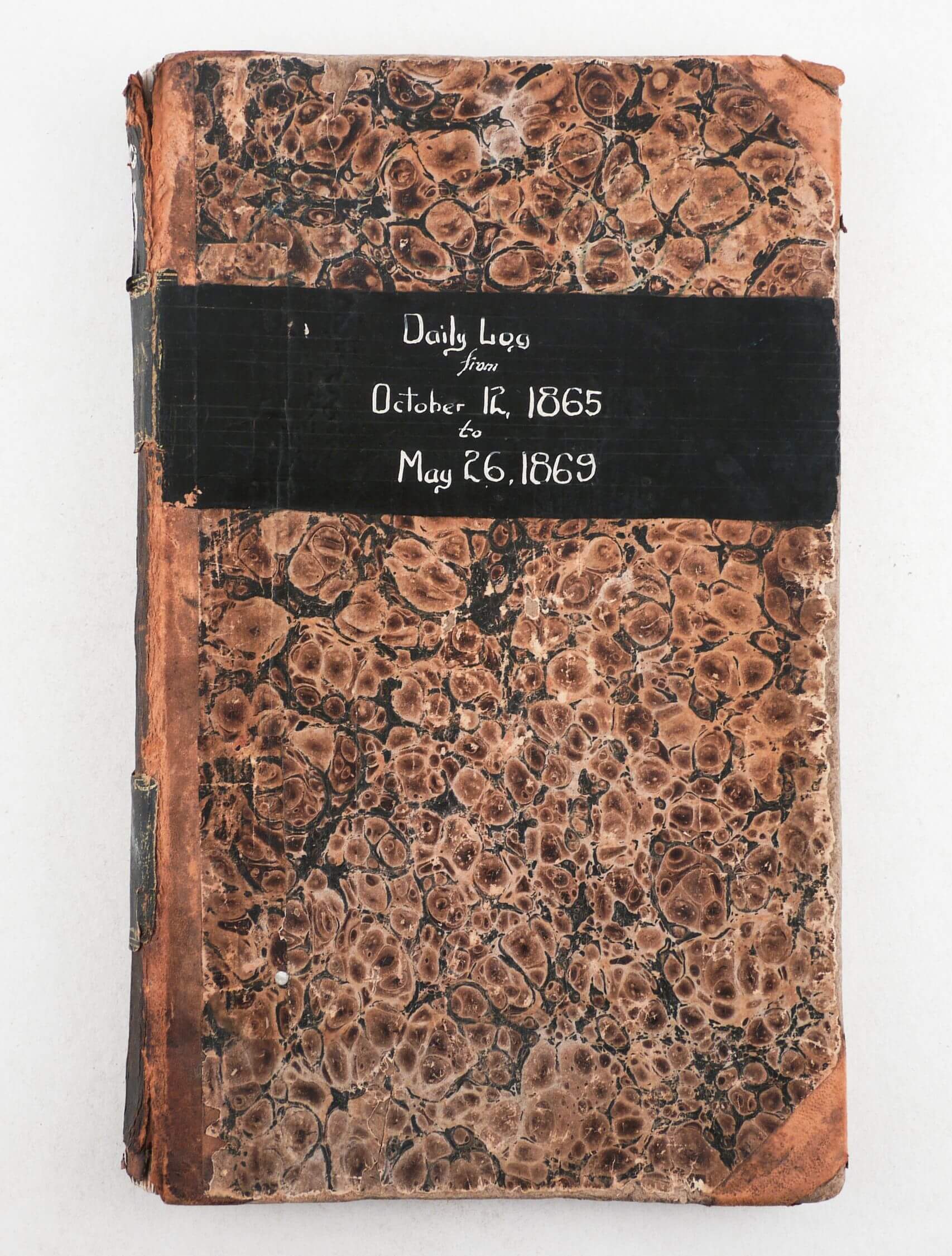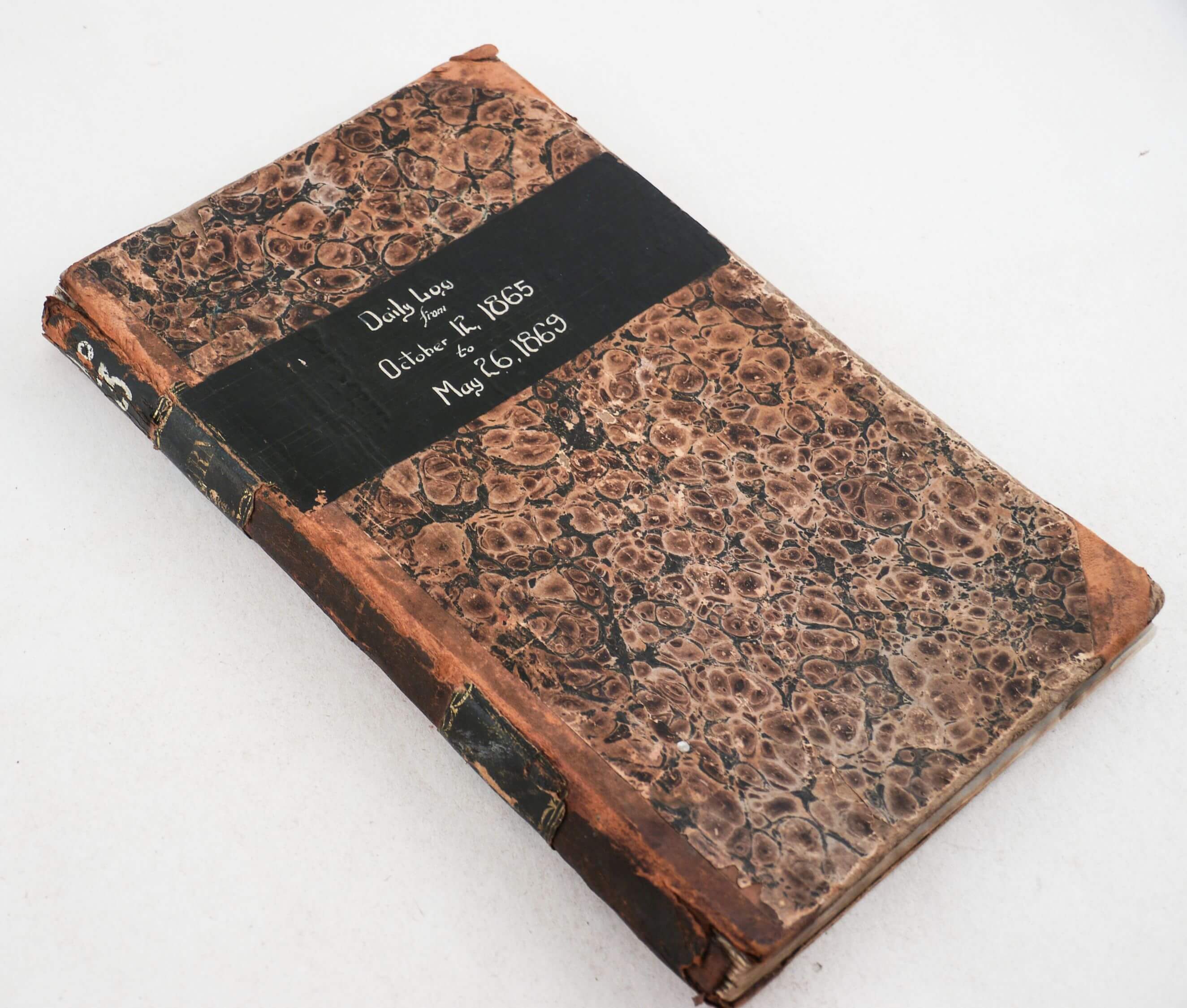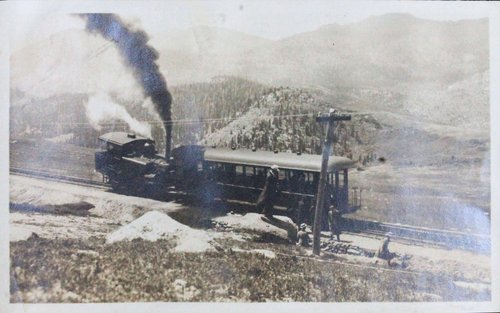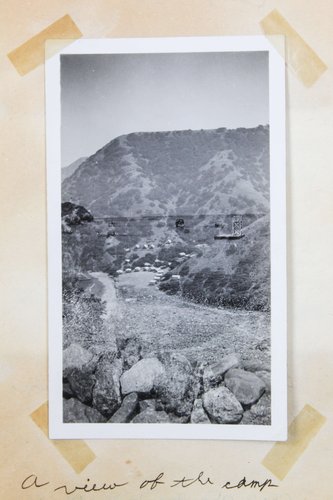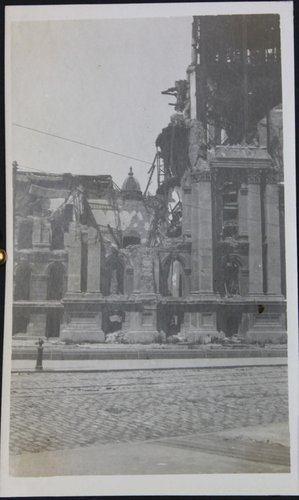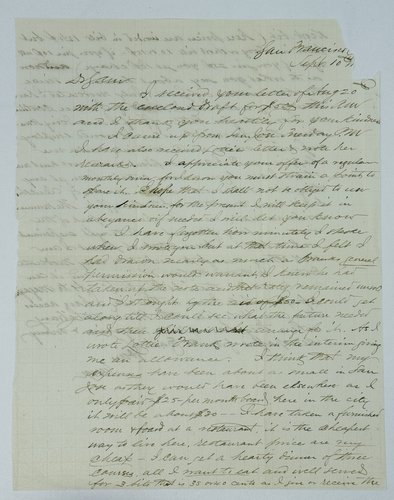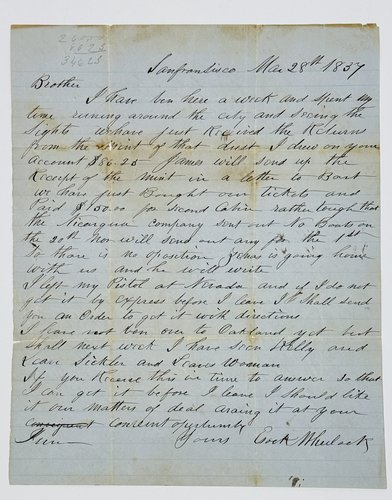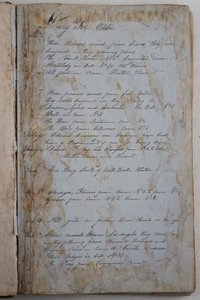
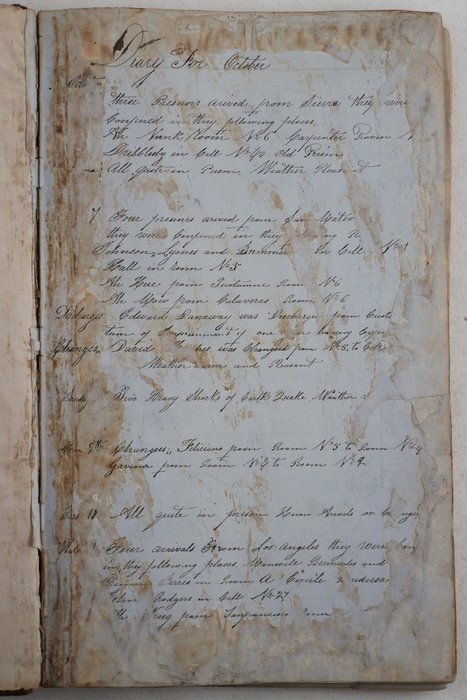
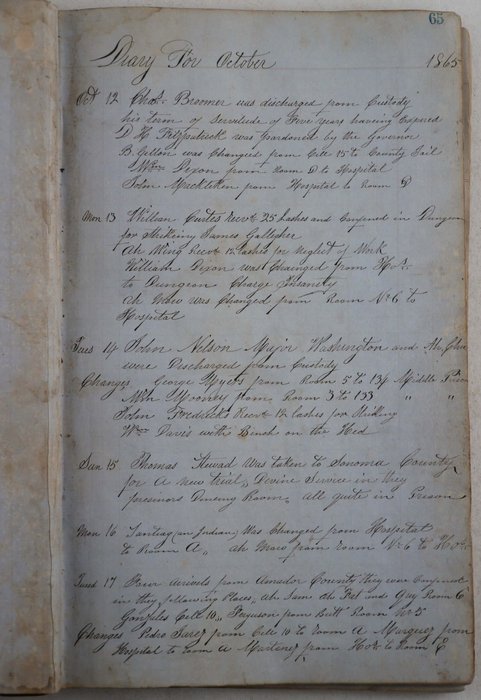
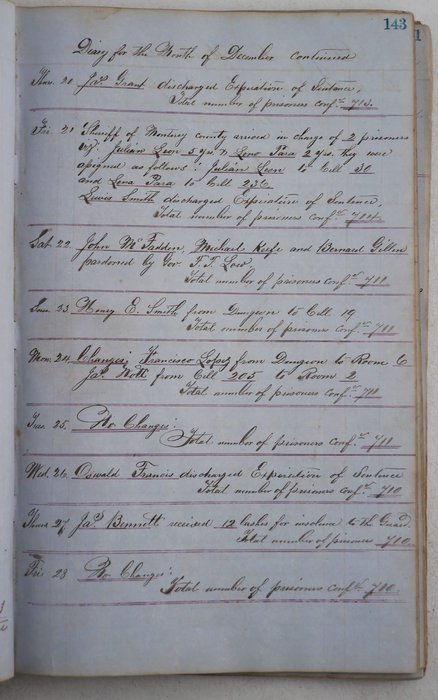
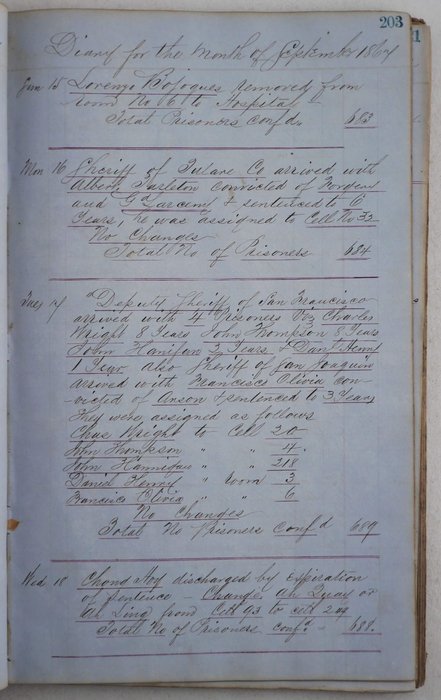
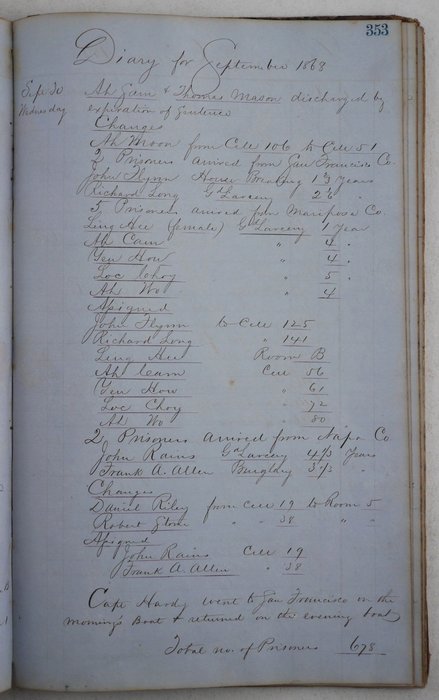
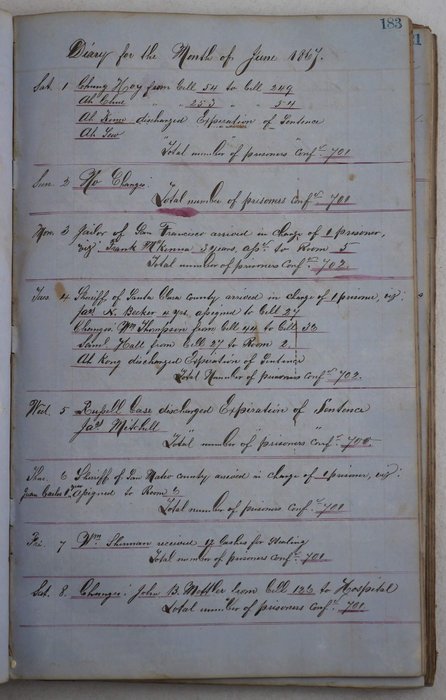
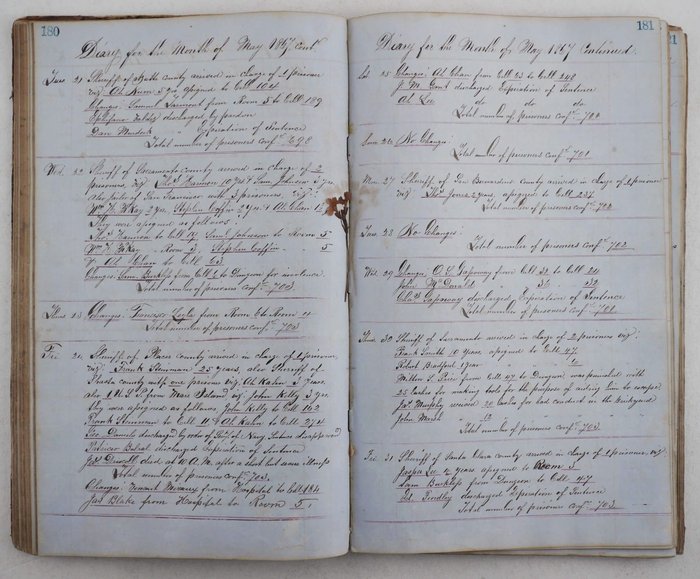

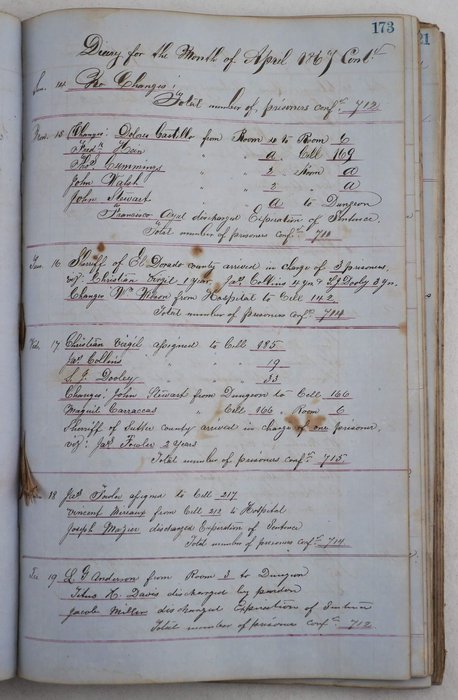

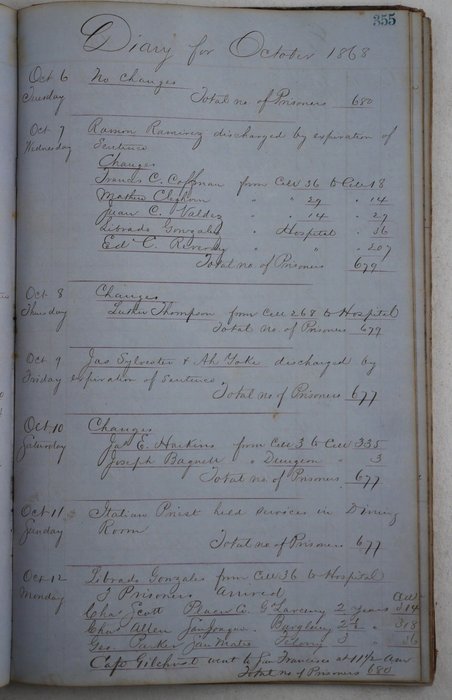
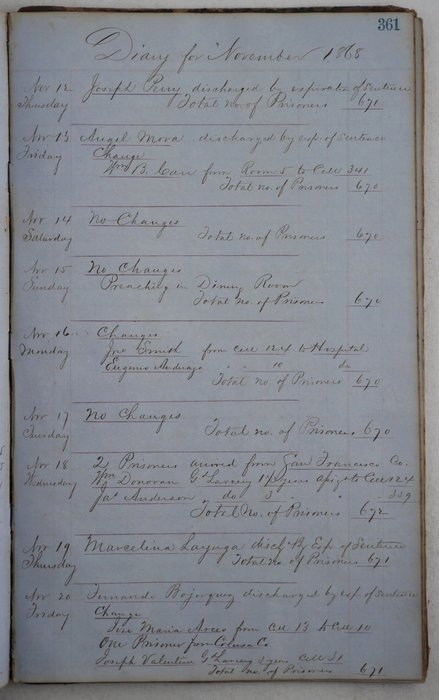
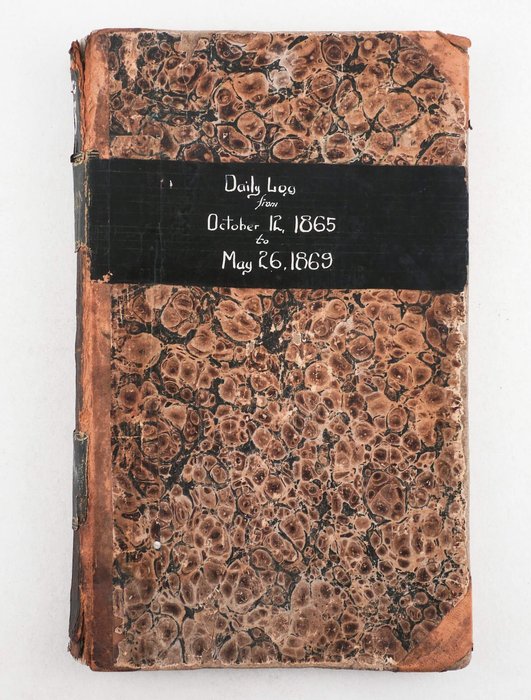
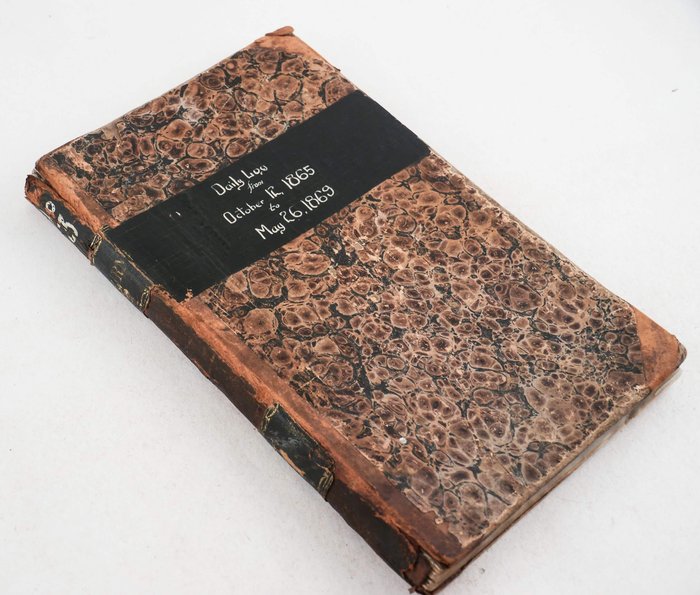
#MB7
Ca. 1860s
Folio Journal (ca. 33x20 cm). Ca. 140 leaves, with printed numbers in the upper corners of recto and verso (from 63 to 400 with some gaps). Most leaves have manuscript entries on recto and verso, about a dozen leaves – on recto only. Brown, black and blue ink on blueish lined paper, frequent red ink markings in text. Period original quarter sheep with marbled papered boards; the spine with faded gilt-lettered title “Journ.” on a black sheep label. Apparently, later manuscript title on the front board. Binding rubbed, spine with cracks on hinges, corners are bumped and with tears, the first leaf is soiled, occasional foxing in text; but overall a very good journal, written in a legible hand.
Historically significant, rare, content-rich original source on the early history of San Quentin prison – the oldest penitentiary in California. San Quentin was established in 1852, opened in 1854 and remained the only penitentiary in California for almost thirty years, until the opening of Folsom State Prison in 1880. This original manuscript journal records the events in San Quentin prison from October 1865 – May 1869 (with a small gap between November 6, 1865 and January 7, 1866), thus covering the second decade of its existence.
The entries generally include information about date and day of the week and the events that took place, such as arrivals or discharges of inmates (often with the indication of their crimes and years of confinement), changes (transfers between cells, the dungeon, hospital, &c.), punishments (lashes, lost commutation time, &c.), pardons, escapes, deaths, visits of government officials, including two California Governors Frederick Low (in office: December 1853 – December 1867) and Henry Haight (in office: December 1867 – December 1871), visits of various societies, Christian services, celebrations, &c. The entries often include information about the total number of inmates on a particular day. Occasional entries record the weather and even mention “two heavy shocks of earthquake” (October 8, 1865, p. [63]). In case of no events, the compiler usually notes: “all quite in prison.” Spelling mistakes are common.
The entries often include full names of the inmates, providing information about nationalities of prisoners, who included people of English and European descent (“John Davis,” “James McConnell,” “John O’Grady,” “Otto Becker,” “John Schmidt,” “Henry Templehoff,” “Stanislaus [Lybrian?]” et al.), Jews (“Abraham Goldstein”), Latin Americans (“Jose Castro,” “Pedro Juarez,” “Perfecto Escalanto,” et al.), Chinese (“Ah Wing”, “Ah Chu”, “Ah Mow” and many others), Native Americans (“Frank (Indian),” “Chappo (Indian),” “John Brown (Indian)”) and others. Several entries record the imprisonment of women: “Catharine McCarthy” (p. 75), “Dolores Castillo” (p. 117), “Margaret Hobbard” (p. 136), “Dolores Figuoroa” (p. 161), “Agnes Miller” (p. 202), and others. Some entries name prison guards (“Captain Fitzpatrick,” “Captain Curtin,” “Captain Hardy”). There are also numerous notes on the names and ranks of the officials who delivered the criminals to the prison: “Sheriff Garigas from Santa Clara” (p. 72), “Jailor from San Francisco” (p. 72), “Deputy Sherriff Morse from Alameda County” (p. 76), “Sheriff Clifford of Trinity County” (p. 77), “a detachment of U.S. Marines from Mare Island” (p. 83), “Deputy Sherriff Belden from Nevada” (p. 86), and others.
The journal sometimes mentions the crimes which caused the imprisonment: larceny (p. 197), manslaughter (p. 198), robbery (p. 202), forgery (p. 203), burglary (p. 205), housebreaking (p. 208), murder (p. 209), jailbreaking (p. 210), assault to murder (p.216), assault with deadly weapon (p. 225), counterfeiting (p. 227), arson (p. 229), felony (p. 243), rape (p. 248), receiving stolen goods (p 254), &c.
Among the violations punished by lashes the journal’s compiler lists “fighting” (p. 201), “stabbing” (p. 216), “abusive language” (p. 112), “keeping fire in his cell at night” (p. 175), “making tools for the purpose of aiding him to escape” (p. 181), “misconduct in the tailor shop” (p. 100), “mutinous conduct toward the guard and employees of the brickyard and fighting” (p. 128), “playing sick” (p. 195), “refusing to work” (pp. 110, 202), “throwing & emptying his night bucket on the prison balcony” (p. 252), “drawing a knife on a prisoner” (p. 259), &c. Placement in the dungeon was given for “carrying contraband correspondence through the gates” (p. 195), “insolence” (p. 180), “contradicting the foreman of his shop” (p. 142), &c.; lost commutation time - for “disobedience of orders” (p. 198), “striking [another prisoner] on the head with a brick” (p. 199), “stealing in shoe shop” (p. 200), &c.
An extensive entry from January 13, 1866 described the assault of the inmates to one of the prison guards, James Fitzpatrick. Pp. 151-154 contain four records of “Earnings by shops in the Cal. State Prison” in May-August 1864, accounting for the money received from the prisoners’ work in private and state blacksmith shops, and government-run tin, mattress, oakum, saddler, lace, show, tailor, carpenter, engraver, paint and upholstery shops. Overall, a valuable content-rich original source on the early history of the oldest prison in California.
Examples of the entries:
Sunday, [October 8, 1865]. Two heavy shocks of earthquake.
Oct. 12, 1865. William Curtes recd. 25 lashes and confined in dungeon for strikeing [sic!] James Galligher. Ah Wing recd. 12 lashes for neglect of work. William Dixon was changed from hos. to dungeon, charge insanity. Ah Mow was changed from room No. 6 to hospital.
Sun. [Oct.] 15, [1865]. Thomas Steward was taken to Sonoma County for a new trial, Devine [sic!] Service in they presinors [sic!] dineing [sic!] room. All quite [sic!] in prison.
Jan. 7, 1866. The Committee appointed by the Legislature made their annual visit to the California State prison, examined all the workshops and everything connected with the institution and expressed themselves highly satisfactory at the result.
Jan. 12, 1866 <…> Edward Lopez while at work in Mr. Stone’s shop met with a severe accident by having three fingers of his left hand cut off. Dr. Thomas was immediately sent for and promptly rendered all nessacery [sic!] surgical aid.
Jan. 13, 1866. <…> At 4 o’clock p.m. while the prisoners were at supper in the dining room, four of them seized Capt. Fitzpatrick by the throat and arms, with the intention of securing him to aid their contemplated escape. Capt. Fitzpatrick was severly [sic!] chocked while in their hands, one of the number named Murphy brandishing a knife over his head, threatening to kill him if he would move an inch. However while engaged with those desperados a man named [Joomy?] rushed to rescue the Cpt. and succeeded in releasing him from his perilous position, at the same time receiving a severe blow on the head with an iron bar in the hands of one named Anderson, who stood at the dining room door with the weapon, threatening to knock down any man who might attempt to escape by the door, but in a short time, seeing that he was baffled, he slunk away among the rest of the prisoners who then came out and went to their respective cells immidiately [sic!], and quit [sic!] was once more restored. At roll call they were all present and the affair ended with the confinement of Anderson from cell 144, Baning from cell 135, Murphy from cell 3 and Robinson from cell 35 to the dungeon.
Sunday, Jan. 14, 1866. <…> Sampson from cell 263, Dawson from cell 272 and Glass alias Finn from cell 275 dug through their cells and escaped during the night, a chisel and several other instruments where [sic!] found with which they dug through the cells, also a rope with which they scaled the wall. Total number of prisoners at 4 p.m. 672 (3 escaped).
Sun., Jan, 21, 1866. Jonas Rodondo broke a finger on his left hand occasioned by sliping [sic!] the bod on his cell door against it.
Sun., Jan. 28, 1866. Dr. McLean, “Trustee” of the Prison Aid Commission of San Francisco, visited the Prison and expressed himself highly pleased at the management of the institution. <…>
Fri., Feb. 9, 1866. The Sheriff of El Dorado County arrived in charge of 2 prisoners, viz. Frank (Indian) – 3 yrs., and Ah Chung, 3 yrs. Wm. Coombs & Saml. Howard discharged by expiration of sentence. <…> Total number of prisoners confd. 667.
Thursday, May 24, 1866. Jose Romano died at 10 o’clock a.m. after a long and severe illness. <…>
Thursday, May 31, 1866. This month past [sic!] off remarcbly quit [sic!], no disturbance or any thing worthy of note having transpired. No of prisoners 901.
Wed, July 11, 1866. Frank Corrydon received 25 lashes for refusing to work. <…>
Wed, August 15, 1866. Sherriff of Los Angelos County arrived in charge of two prisoners, viz.: Dolores Castillo 5 yrs & Domingo Leybo 5 yrs. They were assigned as follows: Dolores Castillo to room 4 & Domingo Leybo to room 6. <…>
Sat, Sept. 8, 1866. Gov. F.F. Low and Secy. Reading arrived from San Francisco at 6 o’clock p.m. <…>
Wed. Sept. 19, 1866. Ah [Talk?] received 25 lashes for willfully destroying a sewing machine in the contractor tailorshop. <…>
Mon. Dec. 3, 1866. Changes: Henry E. Smith from cell 391 to dungeon. He received fifty lashes for attempting to escape by digging from his cell into another opposite and breaking the lock on it, which enabled him to reach the balcony, but was discovered by the guard on duty, before he had time to swing himself off the balcony into the prison yard. <…>
Tue. Dec. 4, 1866. Fred. Hilton, Wm. Church & Billy Potter were accidentally killed at 10 a.m. while endeavoring to open the sink tunnel, Henry Johnson & Ah Wo had a narrow escape from sharing the same fate, they being nearly suffocated by the poisonous gas that circulated through the tunnel.
Sat. May 18, 1867. Senior Jose Godoy, Consul for Mexico and suit [sic!] paid an official visit to the prison and expressed themselves highly pleased at the management of the institution. <…>
Fri. Dec. 20, 1867. <…> The prison was this day transferred [sic!] to the new Democratic administration <…>
Wed. Dec. 25, 1867. A windy & stormy day with heavy showers of rain. In all a dull & disagreable [sic!] Christmas.
Wed. March 4, 1868. Geo. Williams alias Jack Williams escaped on the night of the 3rd inst. while acting as trusty on the outside.
Sun. May 2, 1868. <…> Excursion of the Irish American Benevolunt [sic!] Association.
Tue. May 5, 1868. His Excellency H.H. Haight & Dr. Nickols visited the prison today. 20 guns were fired as a salute.
Sun. May 10, 1868. <…> Excursion of the Fenian Brotherhood. <…>
Sun. Jun. 11, 1868. Excursion of the Montgomery Guards.
Wed. June 17, 1868. Chas. Wright escaped from brick yard.
Sat. Jul. 4, 1868. A salute of 13 guns was fired at sunrise. <…>
Thu. Jul. 9, 1868. A salute was fired at 9 o’clock in the evening in honor of the news of the nomination of Seymour & Blair for President & Vice President of the U. States.
Sun. Jul. 12, 1868. Excursion of the Lumber Stevedores escorted by the Eureka Guard arrived per steamer Contra Costa. <…>


